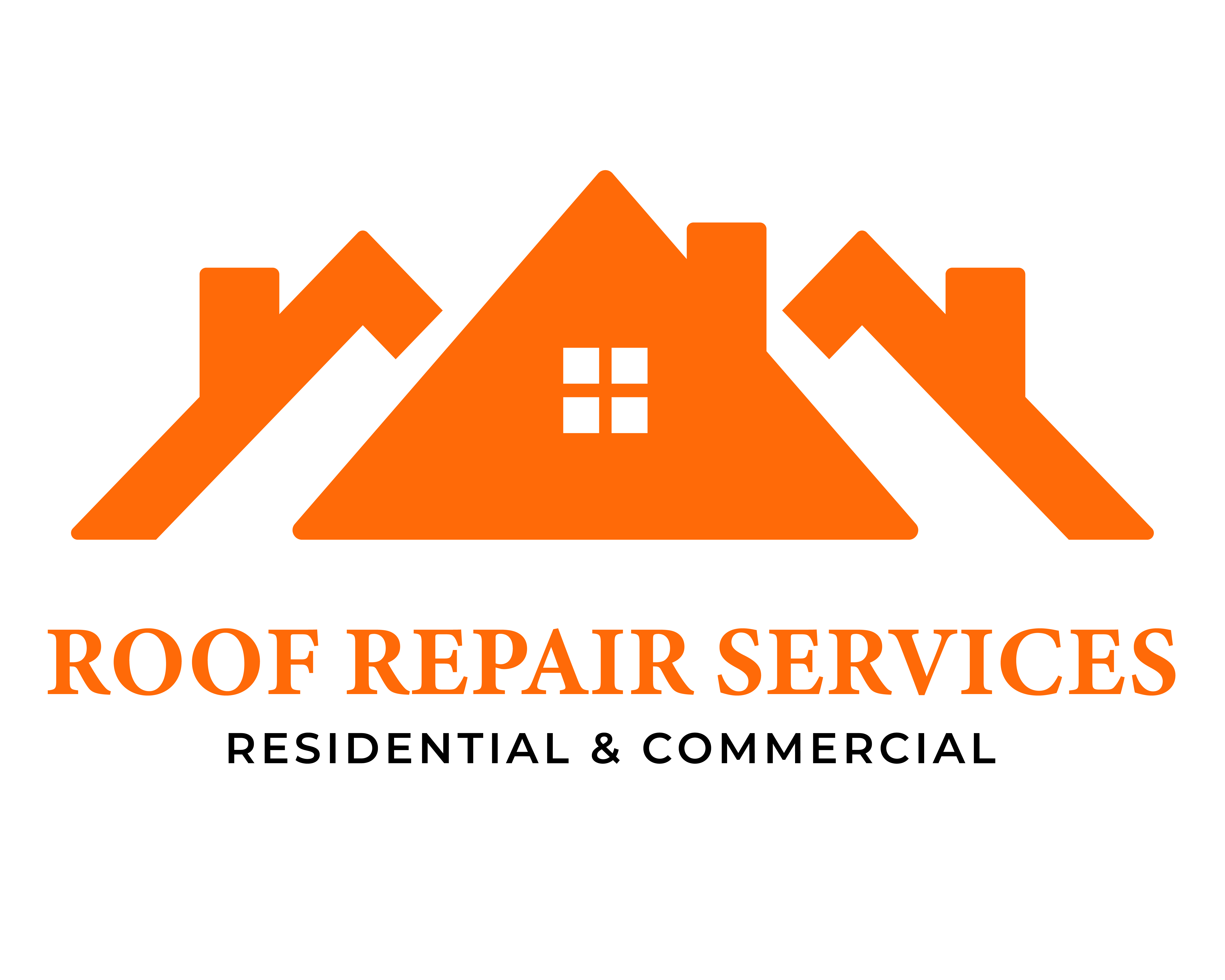What Is Roof Sarking? Understanding the Benefits and Necessity of Roof Insulation
- Home
- What Is Roof Sarking? Understanding the Benefits and Necessity of Roof Insulation
Car Repairing

- September 22, 2023
- By: hostaus
- General
- Comments: 0
What Is Roof Sarking? Understanding the Benefits and Necessity of Roof Insulation
Did you know that your roof plays a crucial role in maintaining a comfortable living space and protecting your home from external elements? “What is roof sarking?” you may ask. Roof sarking is a hidden hero that enhances your roof’s performance, energy efficiency, and overall protection. In this blog post, we’ll uncover the secrets of roof sarking and help you understand why it is an essential component of modern building construction.
Key Takeaways
- Roof sarking is a protective and insulating layer that provides dust barrier, shield from storm-driven rain, thermal performance, bush fire ember protection and condensation control.
- It serves to safeguard roof tiles in bushfire prone areas while reducing energy consumption through reflecting radiant heat away from the structure.
- Regular maintenance of roof sarking is essential for cost effectiveness as well as ensuring its integrity and preventing costly repairs.
Defining Roof Sarking
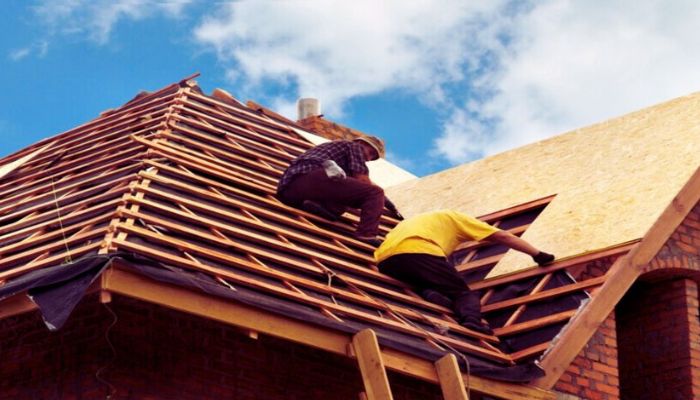
Roof sarking is a protective and insulating layer installed beneath the roof’s outer layer, serving as a shield against various external factors like heat, rain, dust, and even bushfire embers. This versatile solution has gained popularity among homeowners and builders alike for its ability to protect the roof cavity and improve energy efficiency. Available for both tile and metal roofs, it is a strong and pliable laminated membrane composed of a reflective foil layer on one or both sides, reflecting the sun’s radiant heat away from the roof.
Roof sarking primarily functions as:
- A dust barrier
- A shield for the roof cavity from storm-driven rain
- An enhancer of thermal performance
- A resistance to damage from bush fire embers
- A reducer of condensation problems in the roof space
These benefits make roof sarking an essential component of any roof installation, ensuring your home stays comfortable and protected in various weather conditions.
Purpose of Roof Sarking
One of the main purposes of roof sarking is to serve as a barrier against:
- dust
- wind
- rain
- radiant heat
In doing this, it safeguards your roof tiles and other roofing materials, contributing to your roof’s longevity. Additionally, roof sarking is necessary to safeguard homes in bushfire-prone areas from bush fire embers and is obligatory for all structures constructed in areas vulnerable to bushfires from BAL(Bushfire Attack Level) 12.5 to 40.
Apart from its protective functions, roof sarking also plays a vital role in preventing water damage. Acting as an extra layer of protection for the roof space from rain, it helps prevent expensive water damage that could threaten your home’s structural integrity. In essence, roof sarking is like a protective second skin for your roof, shielding it from potential harm and ensuring it performs at its best.
Materials Used
Roof sarking materials generally consist of a thin, pliable sheet with an aluminium foil lining or a synthetic membrane, depending on the roof type. These materials can also act as a vapour barrier, preventing moisture from entering the roof cavity and ensuring that your home stays dry and comfortable even in warmer climates.
Selecting the appropriate sarking material for your roof allows you to reap the benefits of a well-protected and energy-efficient home.
The Importance of Roof Sarking
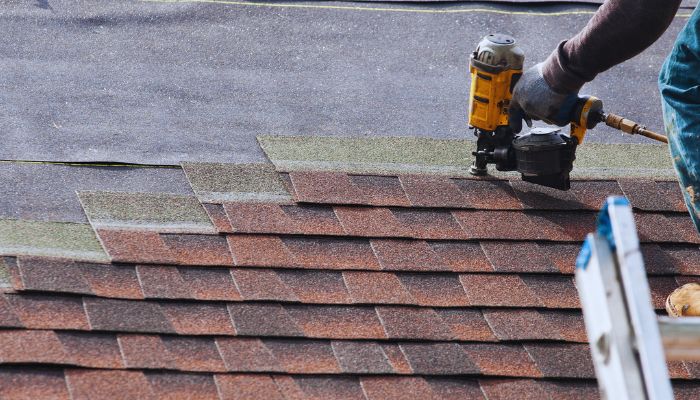
Installing roof sarking in your home is not just a matter of following building codes; it is an investment in the overall performance and longevity of your roof system. Offering thermal efficiency, dependable fire protection, and shielding the roof cavity from possible harm, roof sarking is essential in maintaining a comfortable indoor environment, cutting down energy costs, and safeguarding the tile roof cavity from potential damage.
So, whether you are building a new home or considering a roof upgrade, proper roof insulation with roof sarking is a must.
Energy Efficiency
One of the key advantages of roof sarking is its ability to improve energy efficiency by reflecting radiant heat away from the structure. The reflective foil layer in sarking functions to deflect the sun’s radiant heat away from the home, thus enhancing the insulation of the residence. The result is a more comfortable living environment with reduced energy consumption, as your heating and cooling systems won’t have to work as hard to maintain a comfortable indoor temperature.
When installed properly, roof sarking can effectively reflect radiant heat, thus helping to maintain a comfortable temperature within the house during both summer and winter. This is particularly important in countries like Australia, where temperatures can reach extreme highs and lows throughout the year. Incorporating roof sarking in your home allows for year-round comfort and reduced energy bills.
Moisture Control
Roof sarking offers a protective barrier that helps to reduce moisture build-up, mould growth, and the need for costly repairs by providing insulation between the roof and the space. This is particularly important in areas with high levels of humidity or heavy rainfall, as moisture accumulation can lead to unseen mould growth, structural damage, and even health issues for the occupants.
Serving as an insulating barrier between the roof and the space, roof sarking offers several benefits:
- Stops moisture accumulation and prevents mould growth
- Helps maintain a dry roof cavity
- Results in energy savings
- Reduces repair costs in the long run.
So, if you want to protect your home from the damaging effects of moisture, roof sarking is an essential component of your roofing system.
Roof Sarking for Different Roof Types

Roof sarking is tailored to suit different roof types, providing specific benefits and protection based on the property’s roof material. Be it a metal or tiled roof, sarking has a unique set of advantages and installation requirements for each type.
Understanding the differences and selecting the right sarking material for your roof will ensure maximum protection, energy efficiency, and longevity.
Tiled Roofs
Tiled roofs require sarking for the following reasons:
- To prevent moisture buildup and leaks caused by cracked tiles
- To fill in any spaces left by tiles, including broken tiles
- To ensure the longevity of your tiled roof
- To enhance the energy efficiency of your roof
Roof sarking improves thermal performance and helps maintain the overall integrity of your tiled roof.
In addition to its protective properties, sarking on tiled roofs also serves as an extra layer of insulation, helping to maintain a consistent temperature inside your home and reducing energy costs. Preventing moisture buildup, sarking also aids in averting leaks and expensive water damage, further reinforcing its value as a key component of a well-functioning roof.
Metal Roofs
Metal roof sarking offers insulation, waterproofing, and added acoustic properties to block external noise. This is particularly important for homes in urban areas or near busy roads, where noise pollution can be a significant concern. By installing sarking on metal roofs, homeowners can enjoy a quieter, more peaceful living environment.
In addition to its soundproofing capabilities, sarking for metal roofs also enhances thermal performance in warmer climates. Reflecting the sun’s radiant heat away from the home, sarking helps maintain a cool interior during hot summer months, thus enhancing your home’s energy efficiency.
Overall, metal roof sarking is a valuable addition to any home, providing insulation, waterproofing, and soundproofing capabilities.
Roof Sarking Regulations in Australia
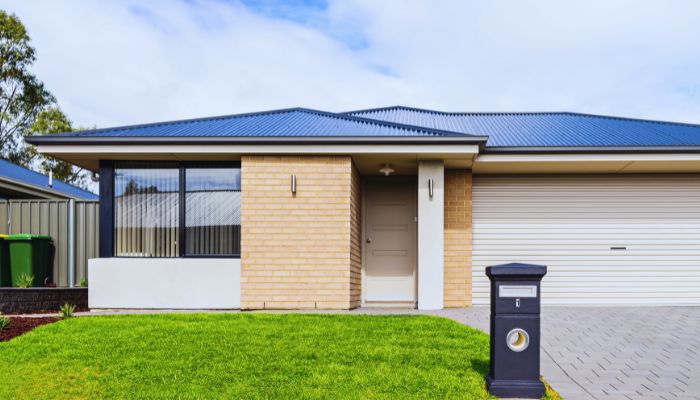
In Australia, roof sarking regulations ensure proper installation and protection for homes in various climates and bushfire-prone areas. Adhering to the mandatory requirements and recommended practices lets homeowners reap the full benefits of roof sarking while keeping their homes compliant with the Building Code of Australia (BCA).
The BCA sets out the minimum requirements for roof sarking, including the type of material to be used, its reflective and insulation properties, as well as the installation methods. These specifications are particularly vital in areas vulnerable to bushfires, where roof sarking acts as a secondary line of defense by preventing embers from penetrating the roof space.
Mandatory Requirements
According to the Building Code of Australia (BCA), the following regulations apply to tiled roofs:
- Full sarking is required when the wind classification exceeds N3.
- Partial sarking is required in lower wind classifications.
- Tiled roofs with a pitch less than 18 degrees must be provided with sarking.
These regulations have been put in place to ensure that homes are adequately protected from external elements and potential damage.
For homes in bushfire-prone areas, roof sarking is obligatory for all structures constructed in areas vulnerable to bushfires from BAL12.5 to 40. Following these mandatory requirements enables homeowners to shield their properties from bushfire embers and other fire-related hazards, ensuring the safety and wellbeing of their families.
Recommended Practices
Retrofitting sarking is recommended for existing roofs to improve energy efficiency and protection. While it may not be mandatory according to building codes, retrofitting sarking can significantly enhance the performance of your roof and provide added benefits in terms of thermal performance and moisture control.
Investing in sarking for your existing roof allows you to enjoy a more comfortable, energy-efficient, and safeguarded home.
Installing Roof Sarking
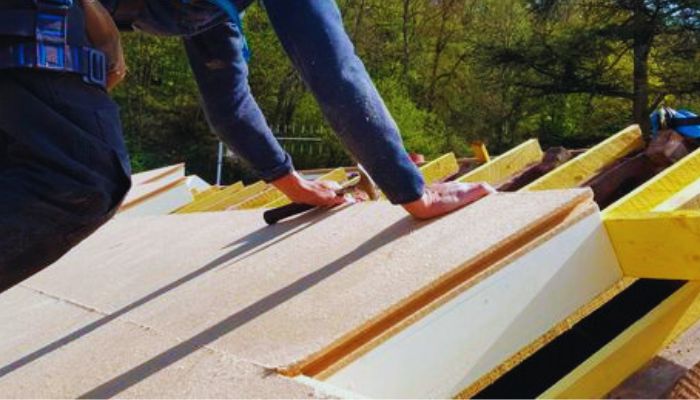
Installing roof sarking can be done during the construction phase or on an existing roof, but professional installation is recommended for optimal results. Hiring a professional to install roof sarking ensures the installation process complies with building codes and the sarking is securely and effectively fitted.
This will guarantee that your home reaps the full benefits of roof sarking, from improved energy efficiency to added protection from external elements.
New Constructions
For new constructions, roof sarking should be installed before roofing materials are put in place, ensuring that it is securely affixed under the battens and properly adhering to building codes. The sarking must be installed in the following steps:
- Unroll the sarking in sections.
- Ensure there is a slight overlap between each layer.
- Securely affix the sarking under the battens.
- Make sure the sarking provides a seamless barrier against moisture and heat.
During the installation process, it is essential to take ventilation and thermal bridging into account, as these factors can impact the overall energy efficiency and performance of your roof sarking. Taking these factors into account during installation can prevent the risk of condensation and ensure that your roof sarking operates optimally.
Existing Roofs
Installing sarking on existing roofs can be complicated and depends on the roof type. Careful consideration of the existing roof structure and the type of sarking material to be used is necessary for successful installation. In some cases, retrofitting sarking may require the removal of existing roofing materials, making the process more time-consuming and labor-intensive.
Due to the complexities involved in installing sarking on existing roofs, it is highly advisable to hire professionals for the task. They possess the expertise and understanding to guarantee that the sarking is installed accurately and securely, ensuring that your home benefits from improved energy efficiency, moisture control, and protection.
Roof Sarking Costs and Maintenance
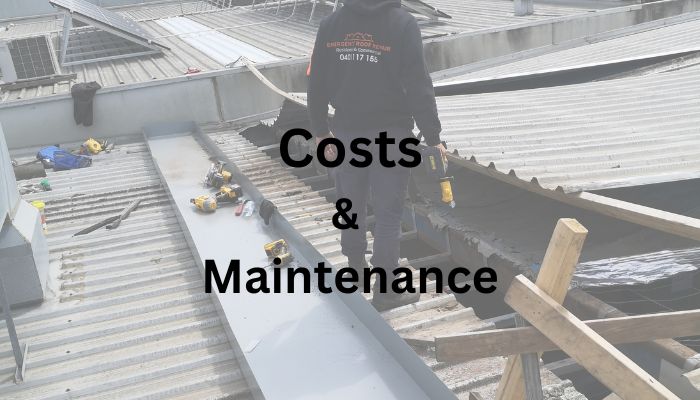
Roof sarking cost and maintenance vary due to various factors. These include the material, thermal rating, and size of the house..
Understanding the factors influencing roof sarking costs and the importance of regular maintenance helps you make informed decisions about the most fitting sarking solution for your home and budget.
Cost Factors
Roof sarking costs range from $5-$10 per square meter, plus installation costs, depending on the type, duty, and thermal rating. Various sarking materials offer different benefits, such as hail protection or additional thermal insulation, which can impact the overall cost. It’s important to factor in your specific needs and the climate in your area when choosing the most appropriate sarking material for your home.
In addition to the cost of the sarking material itself, the installation process can also impact the overall cost of your roof sarking project. Hiring a professional to install your sarking will ensure that the installation is done correctly and securely, but it will also add to the overall cost. However, the benefits of professional installation, such as improved energy efficiency and protection, can outweigh the additional expense in the long run.
Maintenance and Repairs
When you need to repair roof sarking, it’s necessary to address any tears or rips; minor damage can be fixed with tape or patch, but extensive damage requires professional replacement. Regular inspection and maintenance of your roof sarking are essential to ensure its integrity and continued performance. Promptly addressing any issues can prevent more severe damage and expensive repairs in the future.
In addition to routine inspections, it’s important to be proactive in addressing potential issues that could impact your roof sarking’s performance. For example, if you live in an area with frequent storms or high winds, you may need to take additional precautions to secure your sarking and protect it from damage.
Staying vigilant and maintaining your roof sarking allows you to enjoy the perks of a well-protected and energy-efficient home for years to come.
Summary
In conclusion, roof sarking is an essential component of modern building construction, providing numerous benefits such as improved energy efficiency, moisture control, and protection from external elements.
Whether you have a tiled or metal roof, sarking can be tailored to suit your specific needs and adhere to building codes. By understanding the importance of roof sarking, its installation process, and the associated costs and maintenance, you can make informed decisions that will enhance the performance and longevity of your roof, ensuring a comfortable and well-protected home.
Frequently Asked Questions
Is roof sarking necessary?
Roof sarking is highly recommended as it helps to insulate your home, prevents moisture transmission, reflects the sun’s rays and protects against severe weather conditions. It also provides a dust barrier and enhances roof cavity protection, ensuring your home stays safe and comfortable.
What are the disadvantages of roof sarking?
Roof sarking can become worn and brittle with age, leading to moisture and heat loss, as well as damage to the roof structure.
Is sarking required under roof tiles?
Sarking is necessary for all tiled roofs with a pitch less than 18 degrees, as it helps protect the interior of a home from water damage and complies with requirements within the BCA to protect against moisture. Additionally, sarking can divert moisture away from gutters and prevent potential problems in the future.
What is the difference between sarking and insulation?
Sarking is primarily used to help prevent condensation, moisture and water vapour, while insulation is usually made from different materials such as reflective foil.
What is roof sarking?
Roof sarking is a protective layer that provides protection from external elements and improves energy efficiency by increasing insulation.
